Quantitative Proteomic Analysis of MCM3 in ThinPrep Samples of Patients with Cervical Preinvasive Cancer
Abstract
1. Introduction
2. Results
2.1. Defining the Samples
2.2. Distribution of MCM3 and EVPL Values over the Groups
2.3. Evaluation of Concordance between LLETZ Procedure Diagnosis and MCM3 and Envoplakin Proteins
3. Discussion
4. Material and Methods
4.1. Sample Collection and Classification
4.2. Total Protein Quantification
4.3. Sample Preparation
4.4. Proteomics Analysis: Device Conditions, Data Collection, and Identification
4.5. Parallel Reaction Monitoring Quantification of MCM3 Referenced via Stable Isotope Labeled (SIL) Peptides
4.6. Stability of the Protein Content of the Samples
4.7. Statistical Analysis
5. Conclusions
Supplementary Materials
Author Contributions
Funding
Institutional Review Board Statement
Informed Consent Statement
Data Availability Statement
Conflicts of Interest
Abbreviations
| ASC-US | Atypical squamous cells of undetermined significance |
| CDB | Colposcopy-directed biopsy |
| CIN | Cervical intraepithelial neoplasia |
| EVPL | Envoplakin |
| HPV | Human Papillomavirus |
| Hr | High-risk |
| HSIL | High-grade squamous intraepithelial lesion |
| LLETZ | Large loop excision of the transformation zone |
| LSIL | Low-grade squamous intraepithelial lesion |
| ≥LSIL | LSIL and the other higher abnormalities |
| MCM3 | Minichromosome maintenance-3 |
| NILM | Negative for intraepithelial lesion or malignancy |
| Pap smear | Pappanicolau stain cellular smear test |
| PRM | Parallel Reaction Monitoring |
| SCC | Squamous cell carcinoma |
| SIL | Squamous intraepithelial lesions |
References
- Sung, H.; Ferlay, J.; Siegel, R.L.; Laversanne, M.; Soerjomataram, I.; Jemal, A.; Bray, F. Global Cancer Statistics 2020: GLOBOCAN Estimates of Incidence and Mortality Worldwide for 36 Cancers in 185 Countries. CA Cancer J. Clin. 2021, 71, 209–249. [Google Scholar] [CrossRef]
- Gultekin, M.; Ramirez, P.T.; Broutet, N.; Hutubessy, R. World Health Organization Call for Action to Eliminate Cervical Cancer Globally. Int. J. Gynecol. Cancer 2020, 30, 426–427. [Google Scholar] [CrossRef] [PubMed]
- McCredie, M.R.; Sharples, K.J.; Paul, C.; Baranyai, J.; Medley, G.; Jones, R.W.; Skegg, D.C. Natural History of Cervical Neoplasia and Risk of Invasive Cancer in Women with Cervical Intraepithelial Neoplasia 3: A Retrospective Cohort Study. Lancet Oncol. 2008, 9, 425–434. [Google Scholar] [CrossRef] [PubMed]
- Koonmee, S.; Bychkov, A.; Shuangshoti, S.; Bhummichitra, K.; Himakhun, W.; Karalak, A.; Rangdaeng, S. False-Negative Rate of Papanicolaou Testing: A National Survey from the Thai Society of Cytology. Acta Cytol. 2017, 61, 434–440. [Google Scholar] [CrossRef]
- Najib, F.S.; Hashemi, M.; Shiravani, Z.; Poordast, T.; Sharifi, S.; Askary, E. Diagnostic Accuracy of Cervical Pap Smear and Colposcopy in Detecting Premalignant and Malignant Lesions of Cervix. Indian J. Surg. Oncol. 2020, 11, 453–458. [Google Scholar] [CrossRef]
- Jin, G.; Lanlan, Z.; Li, C.; Dan, Z. Pregnancy Outcome Following Loop Electrosurgical Excision Procedure (LEEP) a Systematic Review and Meta-Analysis. Arch. Gynecol. Obstet. 2014, 289, 85–99. [Google Scholar] [CrossRef]
- Frega, A.; Sesti, F.; De Sanctis, L.; Pacchiarotti, A.; Votano, S.; Biamonti, A.; Sopracordevole, F.; Scirpa, P.; Catalano, A.; Caserta, D.; et al. Pregnancy Outcome after Loop Electrosurgical Excision Procedure for Cervical Intraepithelial Neoplasia. Int. J. Gynecol. Obstet. 2013, 122, 145–149. [Google Scholar] [CrossRef] [PubMed]
- Crane, J.M.G. Pregnancy Outcome after Loop Electrosurgical Excision Procedure: A Systematic Review. Obstet. Gynecol. 2003, 102, 1058–1062. [Google Scholar] [CrossRef]
- Grimes, D.R.; Corry, E.M.A.; Malagón, T.; O’Riain, C.; Franco, E.L.; Brennan, D.J. Challenges of False Positive and Negative Results in Cervical Cancer Screening. medRxiv 2020. [Google Scholar] [CrossRef]
- Yang, S.; Wu, Y.; Wang, S.; Xu, P.; Deng, Y.; Wang, M.; Liu, K.; Tian, T.; Zhu, Y.; Li, N.; et al. HPV-Related Methylation-Based Reclassification and Risk Stratification of Cervical Cancer. Mol. Oncol. 2020, 14, 2124–2141. [Google Scholar] [CrossRef]
- Taryma-Leśniak, O.; Sokolowska, K.E.; Wojdacz, T.K. Current Status of Development of Methylation Biomarkers for in Vitro Diagnostic IVD Applications. Clin. Epigenetics 2020, 12, 100. [Google Scholar] [CrossRef] [PubMed]
- Li, N.; Hu, Y.; Zhang, X.; Liu, Y.; He, Y.; van der Zee, A.G.J.; Schuuring, E.; Wisman, G.B.A. DNA Methylation Markers as Triage Test for the Early Identification of Cervical Lesions in a Chinese Population. Int. J. Cancer 2021, 148, 1768–1777. [Google Scholar] [CrossRef] [PubMed]
- Kong, L.; Wang, L.; Wang, Z.; Xiao, X.; You, Y.; Wu, H.; Wu, M.; Liu, P.; Li, L. DNA Methylation for Cervical Cancer Screening: A Training Set in China. Clin. Epigenetics 2020, 12, 91. [Google Scholar] [CrossRef] [PubMed]
- Zhu, H.; Zhu, H.; Tian, M.; Wang, D.; He, J.; Xu, T. DNA Methylation and Hydroxymethylation in Cervical Cancer: Diagnosis, Prognosis and Treatment. Front. Genet. 2020, 11, 347. [Google Scholar] [CrossRef] [PubMed]
- Güzel, C.; Govorukhina, N.I.; Wisman, G.B.A.; Stingl, C.; Dekker, L.J.M.; Klip, H.G.; Hollema, H.; Guryev, V.; Horvatovich, P.L.; van der Zee, A.G.J.; et al. Proteomic Alterations in Early Stage Cervical Cancer. Oncotarget 2018, 9, 18128–18147. [Google Scholar] [CrossRef]
- Forsburg, S.L. Eukaryotic MCM Proteins: Beyond Replication Initiation. Microbiol. Mol. Biol. Rev. 2004, 68, 109–131. [Google Scholar] [CrossRef]
- Lei, M. The MCM Complex: Its Role in DNA Replication and Implications for Cancer Therapy. Curr. Cancer Drug Targets 2005, 5, 365–380. [Google Scholar] [CrossRef]
- Williams, G.H.; Stoeber, K. The Cell Cycle and Cancer. J. Pathol. 2012, 226, 352–364. [Google Scholar] [CrossRef]
- Filho, S.M.A.; Nuovo, G.J.; Cunha, C.B.; Pereira, L.d.O.R.; Oliveira-Silva, M.; Russomano, F.; Pires, A.; Nicol, A.F. Correlation of MCM2 Detection with Stage and Virology of Cervical Cancer. Int. J. Biol. Mark. 2014, 29, 363–371. [Google Scholar] [CrossRef]
- Güzel, C.; van Sten-van’t Hoff, J.; de Kok, I.M.C.M.; Govorukhina, N.I.; Boychenko, A.; Luider, T.M.; Bischoff, R. Molecular Markers for Cervical Cancer Screening. Expert Rev. Proteom. 2021, 18, 675–691. [Google Scholar] [CrossRef]
- Bergeron, C.; Giorgi-Rossi, P.; Cas, F.; Schiboni, M.L.; Ghiringhello, B.; Palma, P.D.; Minucci, D.; Rosso, S.; Zorzi, M.; Naldoni, C.; et al. Informed Cytology for Triaging HPV-Positive Women: Substudy Nested in the NTCC Randomized Controlled Trial. J. Natl. Cancer Inst. 2015, 107, dju423. [Google Scholar] [CrossRef] [PubMed]
- Lai, H.C.; Lin, Y.W.; Huang, T.H.M.; Yan, P.; Huang, R.L.; Wang, H.C.; Liu, J.; Chan, M.W.Y.; Chu, T.Y.; Sun, C.A.; et al. Identification of Novel DNA Methylation Markers in Cervical Cancer. Int. J. Cancer 2008, 123, 161–167. [Google Scholar] [CrossRef] [PubMed]
- Mohammed, F.; Trieber, C.; Overduin, M.; Chidgey, M. Molecular Mechanism of Intermediate Filament Recognition by Plakin Proteins. Biochim. Biophys. Acta Mol. Cell Res. 2020, 1867, 118801. [Google Scholar] [CrossRef] [PubMed]
- Karashima, T.; Watt, F.M. Interaction of Periplakin and Envoplakin with Intermediate Filaments. J. Cell Sci. 2002, 115, 5027–5037. [Google Scholar] [CrossRef] [PubMed]
- Papachristou, E.K.; Roumeliotis, T.I.; Chrysagi, A.; Trigoni, C.; Charvalos, E.; Townsend, P.A.; Pavlakis, K.; Garbis, S.D. The Shotgun Proteomic Study of the Human ThinPrep Cervical Smear Using ITRAQ Mass-Tagging and 2D LC-FT-Orbitrap-MS: The Detection of the Human Papillomavirus at the Protein Level. J. Proteome Res. 2013, 12, 2078–2089. [Google Scholar] [CrossRef]
- Lara Gutiérrez, A.; Lindberg, J.H.; Shevchenko, G.; Gustavsson, I.; Bergquist, J.; Gyllensten, U.; Enroth, S. Identification of Candidate Protein Biomarkers for Cin2+ Lesions from Self-sampled, Dried Cervico–Vaginal Fluid Using Lc-ms/Ms. Cancers 2021, 13, 2592. [Google Scholar] [CrossRef]
- White, E.A. Manipulation of Epithelial Differentiation by Hpv Oncoproteins. Viruses 2019, 11, 369. [Google Scholar] [CrossRef]
- Gyöngyösi, E.; Szalmás, A.; Ferenczi, A.; Kónya, J.; Gergely, L.; Veress, G. Effects of Human Papillomavirus (HPV) Type 16 Oncoproteins on the Expression of Involucrin in Human Keratinocytes. Virol. J. 2012, 9, 36. [Google Scholar] [CrossRef]
- D’Abramo, C.M. Small Molecule Inhibitors of Human Papillomavirus Protein—Protein Interactions. Open Virol. J. 2011, 5, 80–95. [Google Scholar] [CrossRef]
- Longworth, M.S.; Laimins, L.A. Pathogenesis of Human Papillomaviruses in Differentiating Epithelia. Microbiol. Mol. Biol. Rev. 2004, 68, 362–372. [Google Scholar] [CrossRef]
- Song, T.; Seong, S.J.; Lee, S.K.; Kim, B.R.; Ju, W.; Kim, K.H.; Nam, K.; Sim, J.C.; Kim, T.J. Searching for an Ideal Cervical Cancer Screening Model to Reduce False-Negative Errors in a Country with High Prevalence of Cervical Cancer. J. Obstet. Gynaecol. 2020, 40, 240–246. [Google Scholar] [CrossRef]
- Arslan, E.; Gokdagli, F.; Bozdag, H.; Vatansever, D.; Karsy, M. Abnormal Pap-Smear Frequency and Comparison of Repeat Cytological Follow-up with Colposcopy during Patient Management; The Importance of Pathologist’s Guidance in the Management. North Clin. Istanb. 2018, 6, 69–74. [Google Scholar] [CrossRef]
- Leung, K.M.; Lam, K.K.; Tse, P.Y.; Yeoh, G.P.S.; Chan, K.W. Characteristics of False-Negative ThinPrep Cervical Smears in Women with High-Grade Squamous Intraepithelial Lesions. Hong Kong Med. J. 2008, 14, 292–295. [Google Scholar]
- Jung, Y.; Lee, A.R.; Lee, S.J.; Lee, Y.S.; Park, D.C.; Park, E.K. Clinical Factors That Affect Diagnostic Discrepancy between Colposcopically Directed Biopsies and Loop Electrosurgical Excision Procedure Conization of the Uterine Cervix. Obstet. Gynecol. Sci. 2018, 61, 477–488. [Google Scholar] [CrossRef] [PubMed]
- Kim, S.I.; Kim, S.J.; Suh, D.H.; Kim, K.; No, J.H.; Kim, Y.B. Pathologic Discrepancies between Colposcopy-Directed Biopsy and Loop Electrosurgical Excision Procedure of the Uterine Cervix in Women with Cytologic High-Grade Squamous Intraepithelial Lesions. J. Gynecol. Oncol. 2020, 31, e13. [Google Scholar] [CrossRef]
- Perez-Riverol, Y.; Bai, J.; Bandla, C.; García-Seisdedos, D.; Hewapathirana, S.; Kamatchinathan, S.; Kundu, D.J.; Prakash, A.; Frericks-Zipper, A.; Eisenacher, M.; et al. The PRIDE Database Resources in 2022: A Hub for Mass Spectrometry-Based Proteomics Evidences. Nucleic Acids Res. 2022, 50, D543–D552. [Google Scholar] [CrossRef]
- Santesso, N.; Mustafa, R.A.; Wiercioch, W.; Kehar, R.; Gandhi, S.; Chen, Y.; Cheung, A.; Hopkins, J.; Khatib, R.; Ma, B.; et al. Systematic Reviews and Meta-Analyses of Benefits and Harms of Cryotherapy, LEEP, and Cold Knife Conization to Treat Cervical Intraepithelial Neoplasia. Int. J. Gynecol. Obstet. 2016, 132, 266–271. [Google Scholar] [CrossRef] [PubMed]
- Manley, K.M.; Wills, A.K.; Morris, G.C.; Hogg, J.L.; López Bernal, A.; Murdoch, J.B. The Impact of HPV Cervical Screening on Negative Large Loop Excision of the Transformation Zone (LLETZ): A Comparative Cohort Study. Gynecol. Oncol. 2016, 141, 485–491. [Google Scholar] [CrossRef] [PubMed]
- Poomtavorn, Y.; Tanprasertkul, C.; Sammor, A.; Suwannarurk, K.; Thaweekul, Y. Predictors of Absent High-Grade Cervical Intraepithelial Neoplasia (CIN) in Loop Electrosurgical Excision Procedure Specimens of Patients with Colposcopic Directed Biopsy-Confirmed High-Grade CIN. Asian Pac. J. Cancer Prev. 2019, 20, 849–854. [Google Scholar] [CrossRef] [PubMed]
- Gezer, S.; Ozturk, S.K.; Balci, S.; Yucesoy, I. The Concordance between Colposcopic Biopsy and Loop Electrosurgical Excision Procedures (LEEP) in Patients with Known Smear Cytology and Human Papilloma Virus Results. North Clin. Istanb. 2021, 8, 588–594. [Google Scholar] [CrossRef]
- Sherman, M.E.; Kelly, D. High-Grade Squamous Intraepithelial Lesions and Invasive Carcinoma Following the Report of Three Negative Papanicolaou Smears: Screening Failures or Rapid Progression? Mod. Pathol. 1992, 5, 337–342. [Google Scholar]
- Walboomers, J.M.M.; De Roda Husman, A.M.; Snijders, P.J.F.; Stel, H.V.; Risse, E.K.J.; Helmerhorst, T.J.M.; Voorhorst, F.J.; Meijer, C.J.L.M. Human Papillomavirus in False Negative Archival Cervical Smears: Implications for Screening for Cervical Cancer. J. Clin. Pathol. 1995, 48, 728–732. [Google Scholar] [CrossRef]
- Nayani, Z.S.; Hendre, P.C. Comparision and correlation of pap smear with colposcopy and histopathiology in evaluation of cervix. J. Evol. Med. Dent. Sci. 2015, 4, 9236–9247. [Google Scholar] [CrossRef]
- Gardella, B.; Dominoni, M.; Morsia, S.; Gritti, A.; Sosso, C.; Arrigo, A.; Spinillo, A. Multiple Human Papillomavirus Infection and Ascus-Lsil Progression: A Review. Ital. J. Gynaecol. Obstet. 2021, 33, 145. [Google Scholar] [CrossRef]
- Manjee, K.G.; Watkin, W.G. Do Deeper Levels of Cervical Biopsies Preceded by a Pap Smear Diagnosis of LSIL, ASCUS, or NILM/HPV+ Increase the Yield of Identifying Clinically Significant Lesions? Am. J. Clin. Pathol. 2020, 154, S163–S164. [Google Scholar] [CrossRef]
- Duesing, N.; Schwarz, J.; Choschzick, M.; Jaenicke, F.; Gieseking, F.; Issa, R.; Mahner, S.; Woelber, L. Assessment of Cervical Intraepithelial Neoplasia (CIN) with Colposcopic Biopsy and Efficacy of Loop Electrosurgical Excision Procedure (LEEP). Arch. Gynecol. Obstet. 2012, 286, 1549–1554. [Google Scholar] [CrossRef]
- Gu, Y.; Wu, S.L.; Meyer, J.L.; Hancock, W.S.; Burg, L.J.; Linder, J.; Hanlon, D.W.; Karger, B.L. Proteomic Analysis of High-Grade Dysplastic Cervical Cells Obtained from ThinPrep Slides Using Laser Capture Microdissection and Mass Spectrometry. J. Proteome Res. 2007, 6, 4256–4268. [Google Scholar] [CrossRef]
- Zappacosta, R. Thin Prep Gel-Based Proteomics Approach: New Methodology to Give Protein Signature in Residual Cervical Cytology Samples. Biomed. J. Sci. Tech. Res. 2020, 27, 20809–20817. [Google Scholar] [CrossRef]
- Stuebs, F.A.; Schulmeyer, C.E.; Mehlhorn, G.; Gass, P.; Kehl, S.; Renner, S.K.; Renner, S.P.; Geppert, C.; Adler, W.; Hartmann, A.; et al. Accuracy of Colposcopy-Directed Biopsy in Detecting Early Cervical Neoplasia: A Retrospective Study. Arch. Gynecol. Obstet. 2019, 299, 525–532. [Google Scholar] [CrossRef] [PubMed]
- Kabaca, C.; Koleli, I.; Sariibrahim, B.; Karateke, A.; Gurbuz, A.; Kapudere, B.; Cetiner, H.; Cesur, S. Is Cervical Punch Biopsy Enough for the Management of Low-Grade Cervical Intraepithelial Neoplasia? J. Low. Genit. Tract. Dis. 2014, 18, 240–245. [Google Scholar] [CrossRef]
- Witt, B.L.; Factor, R.E.; Jarboe, E.A.; Layfield, L.J. Negative Loop Electrosurgical Cone Biopsy Finding Following a Biopsy Diagnosis of High-Grade Squamous Intraepithelial Lesion Frequency and Clinical Significance. Arch. Pathol. Lab. Med. 2012, 136, 1259–1261. [Google Scholar] [CrossRef] [PubMed]
- Stoler, M.H.; Vichnin, M.D.; Ferenczy, A.; Ferris, D.G.; Perez, G.; Paavonen, J.; Joura, E.A.; Djursing, H.; Sigurdsson, K.; Jefferson, L.; et al. The Accuracy of Colposcopic Biopsy: Analyses from the Placebo Arm of the Gardasil Clinical Trials. Int. J. Cancer 2011, 128, 1354–1362. [Google Scholar] [CrossRef] [PubMed]
- Rebolj, M.; Van Ballegooijen, M.; Berkers, L.M.; Habbema, D. Monitoring a National Cancer Prevention Program: Successful Changes in Cervical Cancer Screening in the Netherlands. Int. J. Cancer 2007, 120, 806–812. [Google Scholar] [CrossRef] [PubMed]
- Makde, M.M.; Sathawane, P. Liquid-Based Cytology: Technical Aspects. Cytojournal 2022, 19, 41. [Google Scholar] [CrossRef] [PubMed]
- Pang, Z.; Zhou, G.; Ewald, J.; Chang, L.; Hacariz, O.; Basu, N.; Xia, J. Using MetaboAnalyst 5.0 for LC–HRMS spectra processing, multi-omics integration and covariate adjustment of global metabolomics data. Nat. Protoc. 2022, 17, 1735–1761. [Google Scholar] [CrossRef]
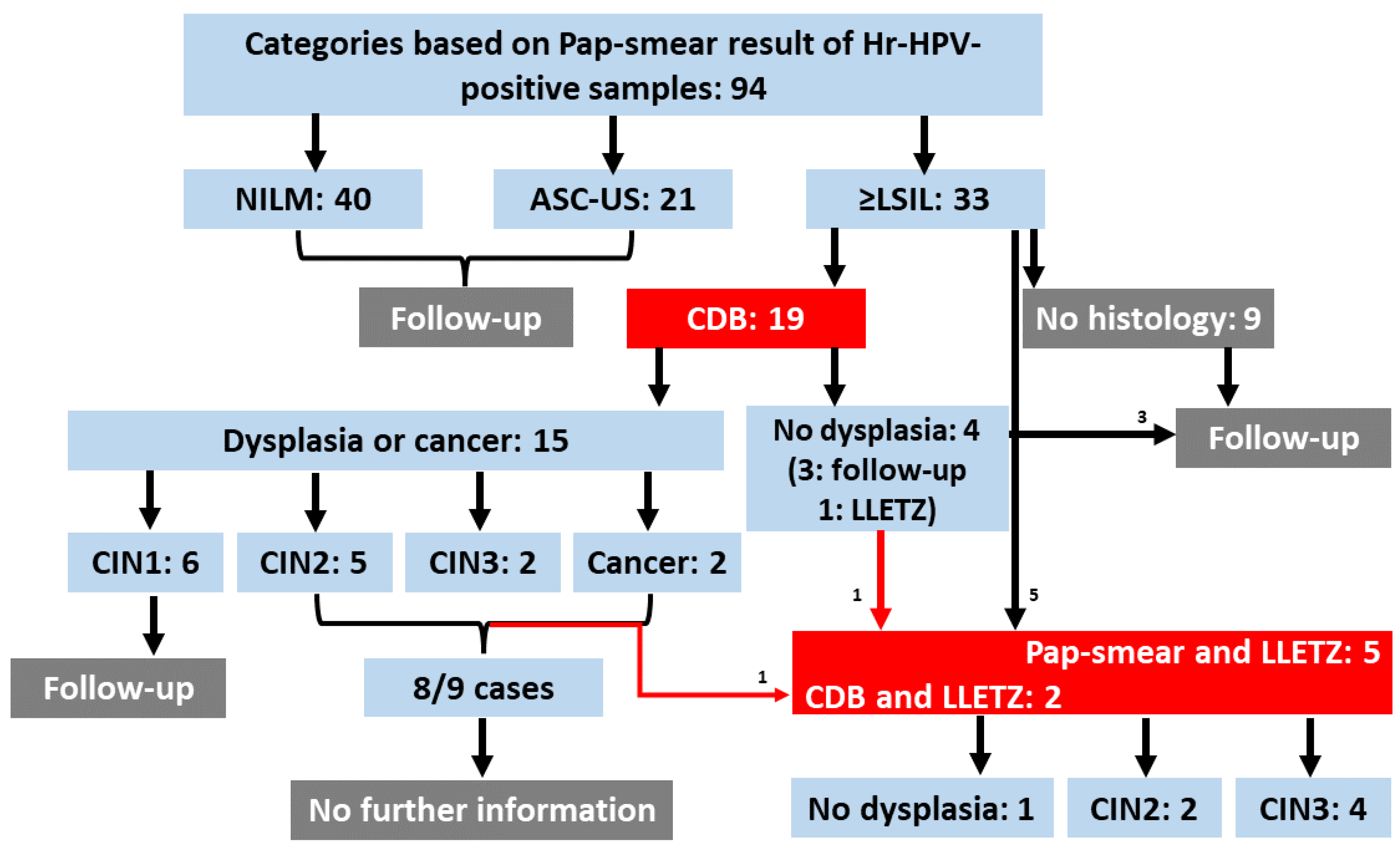
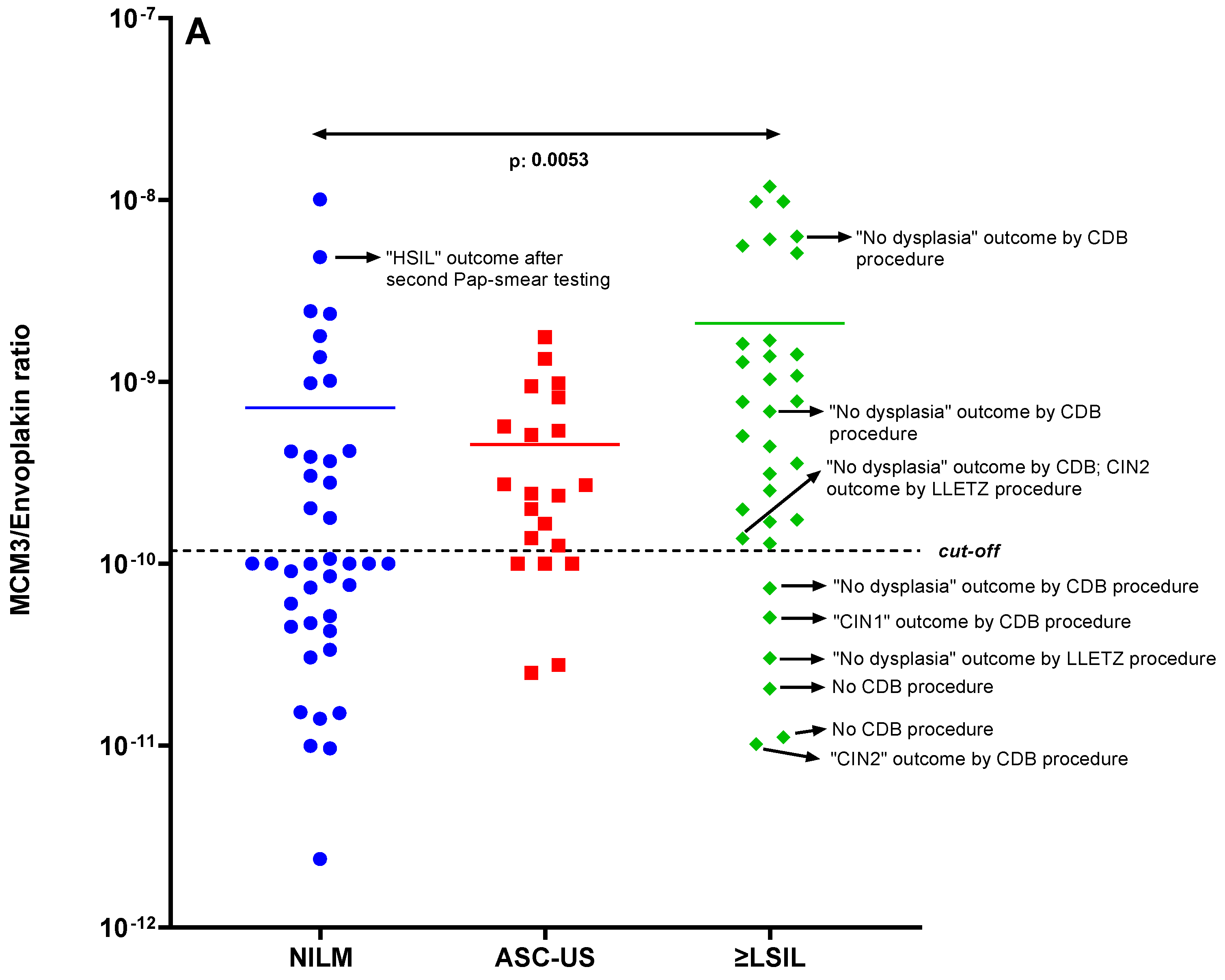
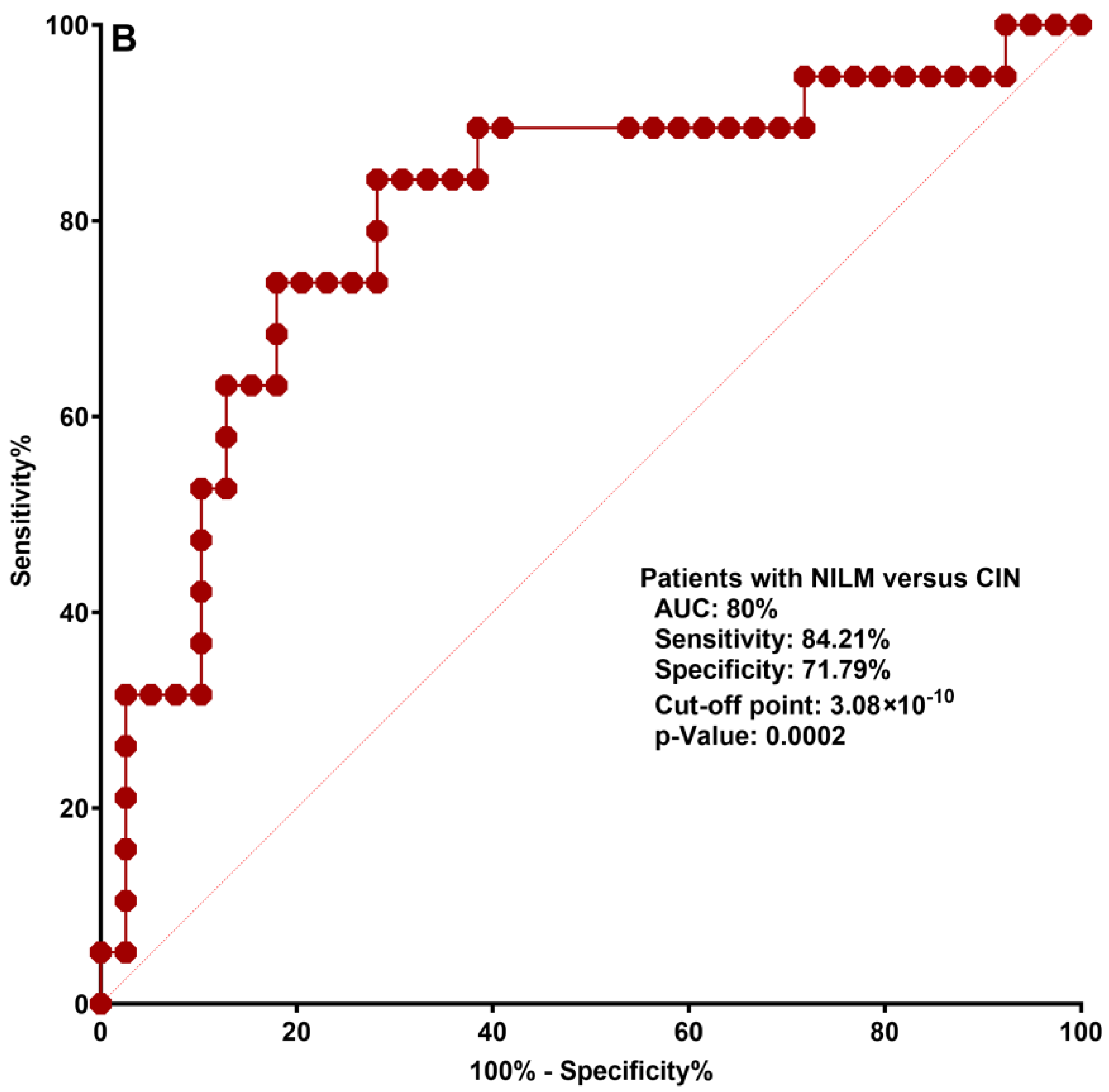
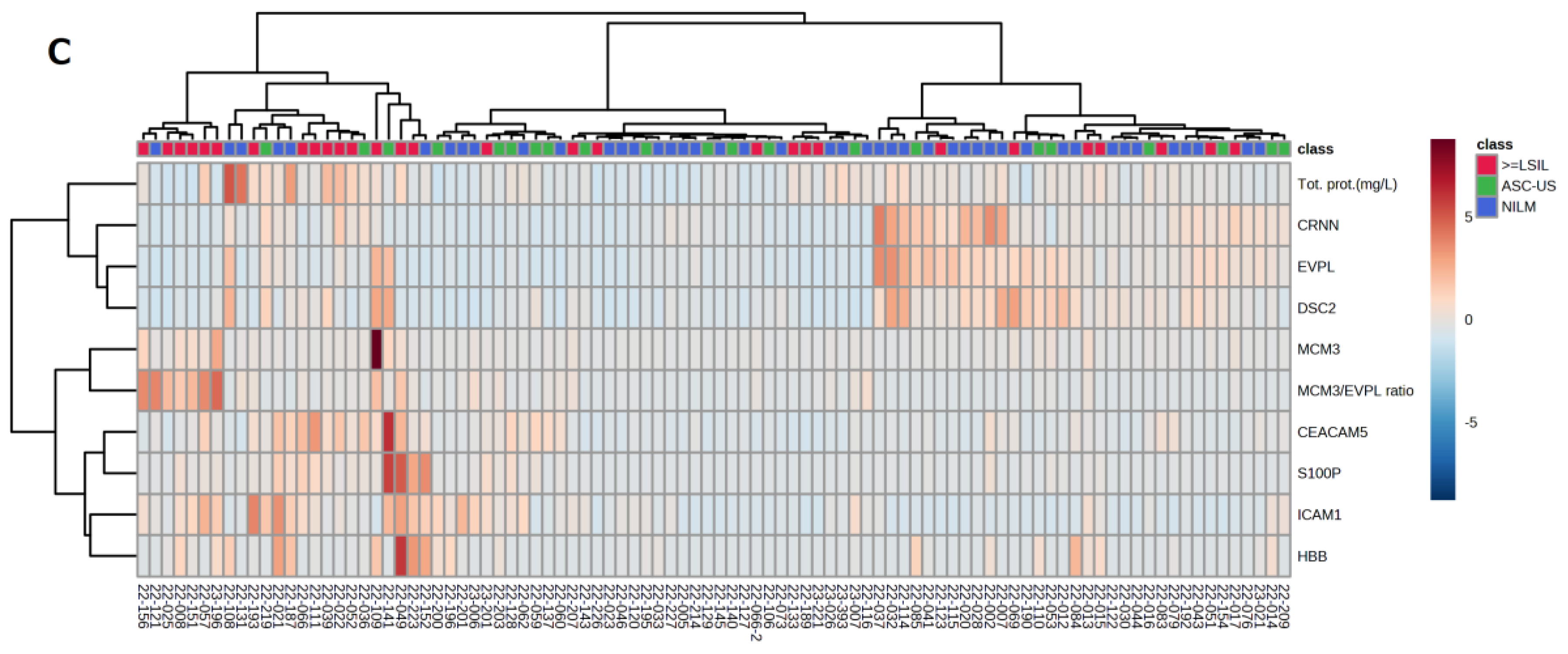
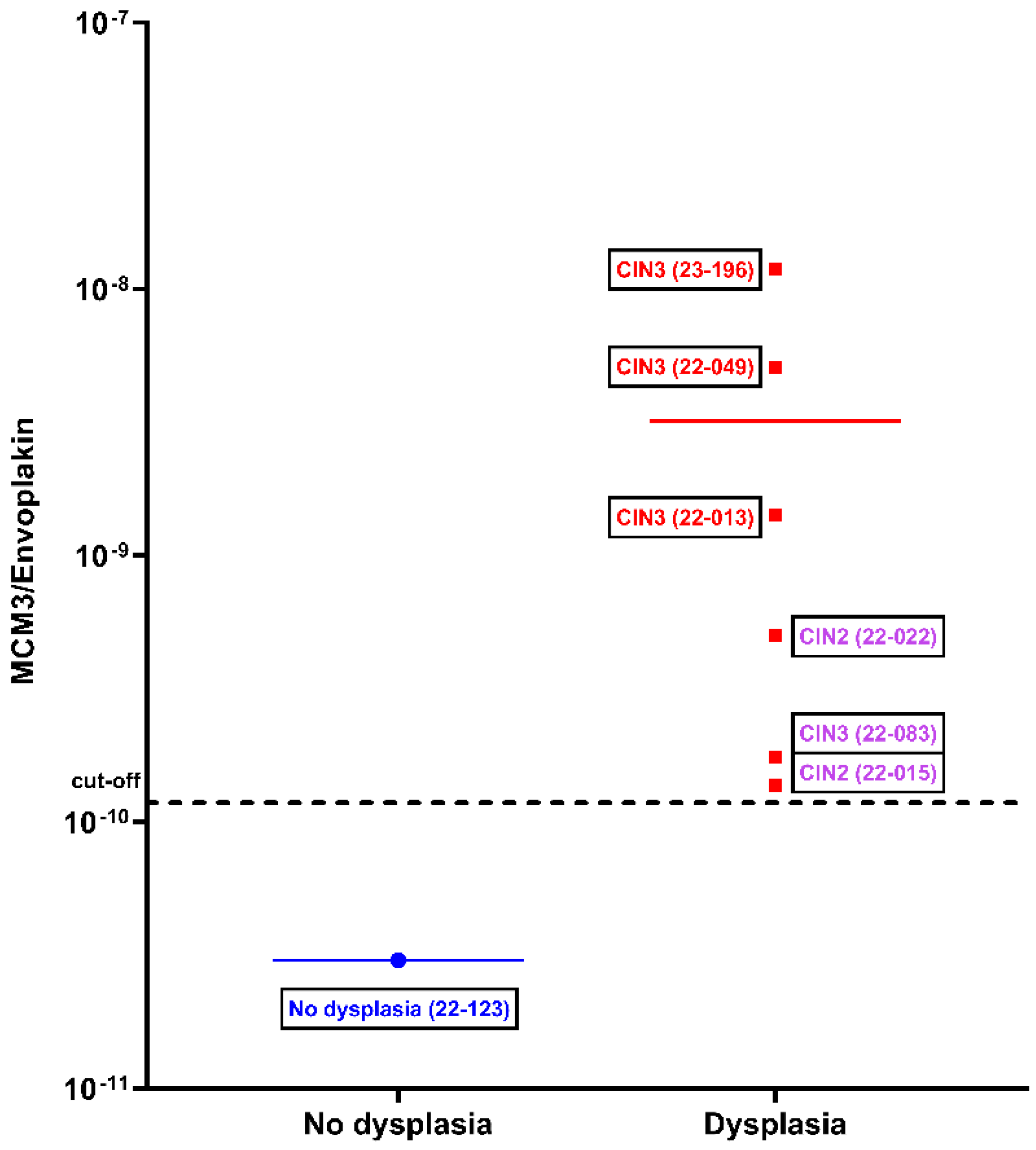
Disclaimer/Publisher’s Note: The statements, opinions and data contained in all publications are solely those of the individual author(s) and contributor(s) and not of MDPI and/or the editor(s). MDPI and/or the editor(s) disclaim responsibility for any injury to people or property resulting from any ideas, methods, instructions or products referred to in the content. |
© 2023 by the authors. Licensee MDPI, Basel, Switzerland. This article is an open access article distributed under the terms and conditions of the Creative Commons Attribution (CC BY) license (https://creativecommons.org/licenses/by/4.0/).
Share and Cite
Köse, B.; Laar, R.v.d.; Beekhuizen, H.v.; Kemenade, F.v.; Baykal, A.T.; Luider, T.; Güzel, C. Quantitative Proteomic Analysis of MCM3 in ThinPrep Samples of Patients with Cervical Preinvasive Cancer. Int. J. Mol. Sci. 2023, 24, 10473. https://doi.org/10.3390/ijms241310473
Köse B, Laar Rvd, Beekhuizen Hv, Kemenade Fv, Baykal AT, Luider T, Güzel C. Quantitative Proteomic Analysis of MCM3 in ThinPrep Samples of Patients with Cervical Preinvasive Cancer. International Journal of Molecular Sciences. 2023; 24(13):10473. https://doi.org/10.3390/ijms241310473
Chicago/Turabian StyleKöse, Büşra, Ralf van de Laar, Heleen van Beekhuizen, Folkert van Kemenade, Ahmet Tarik Baykal, Theo Luider, and Coşkun Güzel. 2023. "Quantitative Proteomic Analysis of MCM3 in ThinPrep Samples of Patients with Cervical Preinvasive Cancer" International Journal of Molecular Sciences 24, no. 13: 10473. https://doi.org/10.3390/ijms241310473
APA StyleKöse, B., Laar, R. v. d., Beekhuizen, H. v., Kemenade, F. v., Baykal, A. T., Luider, T., & Güzel, C. (2023). Quantitative Proteomic Analysis of MCM3 in ThinPrep Samples of Patients with Cervical Preinvasive Cancer. International Journal of Molecular Sciences, 24(13), 10473. https://doi.org/10.3390/ijms241310473






